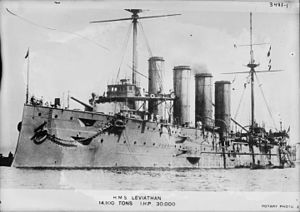HMS Leviathan (1901)

HMS Leviathan at anchor
|
|
| History | |
|---|---|
|
|
|
| Name: | HMS Leviathan |
| Namesake: | Leviathan |
| Builder: | John Brown & Company, Clydebank |
| Laid down: | 30 November 1899 |
| Launched: | 3 July 1901 |
| Christened: | Lady Inverclyde |
| Completed: | 16 June 1903 |
| Fate: | Sold for scrap, 3 March 1920 |
| General characteristics | |
| Class and type: | Drake-class armoured cruiser |
| Displacement: | 14,150 long tons (14,380 t) (normal) |
| Length: | 533 ft 6 in (162.6 m) (o/a) |
| Beam: | 71 ft 4 in (21.7 m) |
| Draught: | 26 ft (7.9 m) |
| Installed power: |
|
| Propulsion: |
|
| Speed: | 23 knots (43 km/h; 26 mph) |
| Complement: | 900 |
| Armament: |
|
| Armour: | |
HMS Leviathan was one of four Drake-class armoured cruisers built for the Royal Navy around 1900. She was assigned to the China Station upon completion and then served in the Mediterranean Fleet in 1905–06. She was assigned to the 7th Cruiser Squadron in 1907 before she was briefly reduced to reserve. Leviathan was recommissioned in 1909 for service with the 4th Cruiser Squadron before she was placed in reserve in 1913.
Recommissioned in mid-1914, she was assigned to the 6th Cruiser Squadron of the Grand Fleet at the beginning of World War I. She spent most of the rest of the year searching for German commerce raiders and escorting convoys before she became flagship of the 1st Cruiser Squadron. In early 1915, she was reassigned to the 6th Cruiser Squadron before she became flagship of the North America and West Indies Station in March. Leviathan retained that position for the next three years until she was relieved as flagship in early 1918 and began escorting convoys from North America to Britain. She was placed in reserve in 1919 and sold for scrap in early 1920.
Leviathan was designed to displace 14,150 long tons (14,380 t). The ship had an overall length of 553 feet 6 inches (168.7 m), a beam of 71 feet 4 inches (21.7 m) and a deep draught of 26 feet 9 inches (8.2 m). She was powered by two 4-cylinder triple-expansion steam engines, each driving one shaft, which produced a total of 30,000 indicated horsepower (22,000 kW) and gave a maximum speed of 23 knots (43 km/h; 26 mph). The engines were powered by 43 Belleville boilers. She carried a maximum of 2,500 long tons (2,500 t) of coal and her complement consisted of 900 officers and enlisted men.
...
Wikipedia
